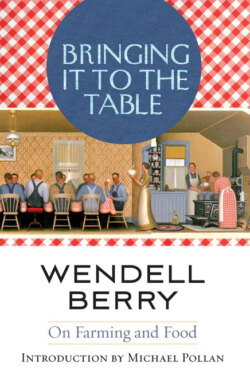Читать книгу Bringing It to the Table - Wendell Berry - Страница 9
I. CONFINEMENT, CONCENTRATION, SEPARATION
ОглавлениеMY TASK HERE is to show the great stupidity of industrial animal production. Factory farms, like this essay, have the aim of cramming as much as possible into as small a space as possible. To understand these animal factories, we need to keep in mind three principles: confinement, concentration, and separation.
The principle of confinement in so-called animal science is derived from the industrial version of efficiency. The designers of animal factories appear to have had in mind the example of concentration camps or prisons, the aim of which is to house and feed the greatest number in the smallest space at the least expense of money, labor, and attention. To subject innocent creatures to such treatment has long been recognized as heartless. Animal factories make an economic virtue of heartlessness toward domestic animals, to which humans owe instead a large debt of respect and gratitude.
The defenders of animal factories typically assume, or wish others to assume, that these facilities concentrate animals only. But that is not so. They also concentrate the excrement of the animals—which, when properly dispersed, is a valuable source of fertility, but, when concentrated, is at best a waste, at worst a poison.
Perhaps even more dangerous is the inevitability that large concentrations of animals will invite concentrations of disease organisms, which in turn require concentrated and continuous use of antibiotics. And here the issue enlarges beyond the ecological problem to what some scientists think of as an evolutionary problem: The animal factory becomes a breeding ground for treatment-resistant pathogens, exactly as large field monocultures become breeding grounds for pesticide-resistant pests.
To concentrate food-producing animals in large numbers in one place inevitably separates them from the sources of their feed. Pasture and barnyard animals are removed from their old places in the order of a diversified farm, where they roamed about in some freedom, foraging to a significant extent for their own food, grazing in open pastures, or recycling barnyard and household wastes. Confined in the pens of animal factories, they are made dependent almost exclusively upon grains which are grown in large monocultures, at a now generally recognized ecological cost, and which must be transported to the animals sometimes over long distances. Animal factories are energy-wasting enterprises flourishing in a time when we need to be thinking of energy conservation.
The industrialization of agriculture, by concentration and separation, overthrows the restraints inherent in the diversity and balance of healthy ecosystems and good farms. This results in an unprecedented capacity for overproduction, which drives down farm income, which separates yet more farmers from their farms. For the independent farmers of the traditional small family farm, the animal factories substitute hired laborers, who at work are confined in the same unpleasant and unhealthy situation as the animals. Production at such a cost is temporary. The cost finally is diminishment of the human and ecological capacity to produce.
Animal factories ought to have been the subject of much government concern, if government is in fact concerned about the welfare of the land and the people. But, instead, the confined animal feeding industry has been the beneficiary of government encouragement and government incentives. This is the result of a political brain disease that causes people in power to think that anything that makes more money or “creates jobs” is good.
We have animal factories, in other words, because of a governmental addiction to short-term economics. Short-term economics is the practice of making as much money as you can as fast as you can by any possible means while ignoring the long-term effects. Short-term economics is the economics of self-interest and greed. People who operate on the basis of short-term economics accumulate large “externalized” costs, which they charge to the future—that is, to the world and to everybody’s grandchildren.
People who are concerned about what their grandchildren will have to eat, drink, and breathe tend to be interested in long-term economics. Long-term economics involves a great deal besides the question of how to make a lot of money in a hurry. Long-term economists such as John Ikerd of the University of Missouri believe in applying “the Golden Rule across the generations—doing for future generations as we would have them do for us.” Professor Ikerd says: “The three cornerstones of sustainability are ecological soundness, economic viability, and social justice.” He thinks that animal factories are deficient by all three measures.
These factories raise issues of public health, of soil and water and air pollution, of the quality of human work, of the humane treatment of animals, of the proper ordering and conduct of agriculture, and of the longevity and healthfulness of food production.
If the people in our state and national governments undertook to evaluate economic enterprises by the standards of long-term economics, they would have to employ their minds in actual thinking. For many of them, this would be a shattering experience, something altogether new, but it would also cause them to learn things and do things that would improve the lives of their constituents.
